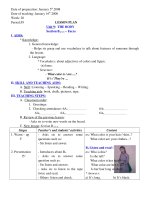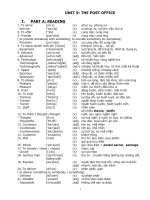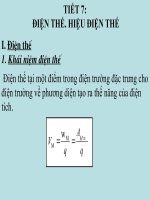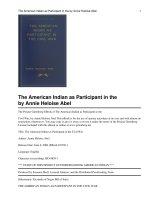5 9 the civil war sisterhood
Bạn đang xem bản rút gọn của tài liệu. Xem và tải ngay bản đầy đủ của tài liệu tại đây (3.32 MB, 10 trang )
The Civil War
Sisterhood
Fascinating Facts
•
Clara Barton discovered that a soldier she was treating was
a woman. Barton helped the woman get back together
with her husband. The couple named their daughter after
Clara Barton.
Women Who Made a Difference
• Because she became ill, Harriet Tubman was unable to
join John Brown in his raid on Harper’s Ferry.
• When Confederate spy Belle Boyd was returning from
Europe, her ship was captured by the Union navy. She fell
in love with a Union naval officer and married him.
Genre
Nonfiction
Comprehension Skill
Main Ideas and
Details
Text Features
• Captions
• Sidebar
Scott Foresman Social Studies
ISBN 0-328-14902-0
ì<(sk$m)=bejacf< +^-Ä-U-Ä-U
by Joan Nichols
The Civil War was a hard-fought struggle that drained the
energies and resources of Americans, both North and South.
Hundreds of thousands of lives were lost on both the Union
and Confederate sides. How did women respond to the war’s
challenges? Read about some of the many brave and resourceful
women who made a difference during these troubled times.
Write to It!
Women throughout history have often faced challenges
by taking on roles not expected of them. Write three
paragraphs about a woman from the past or present you
admire. Discuss the challenges she faced and why she
should be remembered.
The Civil War
Sisterhood
Women Who Made a Difference
Vocabulary
Write your profile on a separate sheet of paper.
free state
slave state
secede
home front
draft
regiment
courier
Photographs
by Joan Nichols
Every effort has been made to secure permission and provide appropriate credit for photographic material.
The publisher deeply regrets any omission and pledges to correct errors called to its attention in subsequent editions.
Unless otherwise acknowledged, all photographs are the property of Scott Foresman, a division of Pearson Education.
Photo locators denoted as follows: Top (T), Center (C), Bottom (B), Left (L), Right (R), Background (Bkgd).
ISBN: 0-328-14902-0
Copyright © Pearson Education, Inc. All Rights Reserved. Printed in the
United States of America. This publication or parts thereof, may be used with appropriate
equipment to reproduce copies for classroom use only.
1 2 3 4 5 6 7 8 9 10 V0G1 14 13 12 11 10 09 08 07 06 05
Opener: ©Bettmann/Corbis
2 North Wind Picture Archives
Editorial Offices: Glenview, Illinois • Parsippany, New Jersey • New York, New York
3 North Wind Picture Archives
4 (B1) Hulton-Deutsch Collection/Corbis,
Getty Images
Sales Offices:(B2)
Needham,
Massachusetts • Duluth, Georgia • Glenview, Illinois
5 The Granger Collection, New York
Coppell,
Texas
•
Ontario, California • Mesa, Arizona
8 (B) Library of Congress, (T) The Granger Collection, NY
9 Corbis
11 (B) Duke University, Rare Books, Manuscript & Special Collections Library, (T) The Granger Collection, NY
12 ©Bettmann/Corbis
13 ©Bettmann/Corbis
15 The Granger Collection, NY
The Abolitionists
Many women who were abolitionists made a difference
before the Civil War even began. They wrote books
and pamphlets against slavery and spoke out in public
lectures.
Sarah and Angelina Grimke were daughters of wealthy
South Carolina slave owners, so they grew up surrounded
by enslaved people. Yet they were among the first
abolitionists. From their earliest years, they believed that
all people were created equal.
Hating slavery even as a child, Sarah Grimke said slavery “marred
[spoiled] my comfort from the time I can remember myself.”
2
The Grimke sisters moved north to write and speak
out against slavery. Many people criticized them, because
in those days, women were not supposed to lecture in
public. Others, however, were impressed by these former
slave owners who spoke out so strongly against slavery.
Because Sojourner Truth was born enslaved, she knew
the horrors of slavery from her own life. With a sharp
wit, strong voice, and commanding presence, she was in
demand as a speaker at anti-slavery meetings.
Angelina Grimke was Sarah’s younger sister. In school one day, she
was so upset she fainted when she saw an African American boy
who had been badly beaten.
3
Two Harriets
Harriet Beecher Stowe was neither a Southerner nor
a former slave. She was a Northerner, born in 1811 in
Connecticut, a free state. In 1832 she moved to Ohio,
another free state, and across the Ohio River from
Kentucky, a slave state. Here she came in contact with
slavery and escaping enslaved people for the first time.
A friend described seeing an African American woman
carrying her baby across the icebound Ohio River. Stowe
used this story when she wrote Uncle Tom’s Cabin. Her
novel moved her readers and made them see enslaved
people as fellow human beings. The novel sold over ten
thousand copies in the first week and became a bestseller
all over the world.
Born enslaved, Harriet Tubman escaped from slavery in 1849. She
was so thrilled to reach free territory that she said, “I looked at my
hands to see if I were the same person.”
While most abolitionists gave speeches and wrote books
to fight slavery, Harriet Tubman risked her own life and
freedom by helping enslaved people escape. She traveled
to the South eighteen times to lead people to the North,
where they would be free. Even though there was a large
reward offered for her capture, she was never caught.
The Woman Behind the Song
Supposedly when President Abraham Lincoln met Harriet Beecher
Stowe, he said, “So you’re the little woman who wrote the book
that started this Great War!”
4
You may have heard the song that begins, “Mine eyes
have seen the glory.” Julia Ward Howe had heard some
Union soldiers singing a popular marching song called
“John Brown’s Body.” The next morning, she wrote new
words to the tune and sent them to The Atlantic Monthly
magazine. Soon “The Battle Hymn of the Republic” was
sung all over the North.
5
The Home Front
Nurses
After the South seceded, the fighting began. On the
home front, away from the main battles, women fought
their own war. Many women worked hard and showed
courage defending their homes and supporting the cause
in which they believed.
Almost half the men in the North and about 80
percent of the men in the South joined the army or
were called up by the draft, leaving the family farms and
businesses for the women to run. And they did—under
difficult circumstances, such as shortages of food and
clothing, especially in the South.
Poorer women had to go to work in war industries to
support their families. To make ends meet, or just to help
the cause, they sewed uniforms and manufactured rifle
cartridges.
Despite the additional work, women still found time
to help the soldiers. They joined together in their own
homes to roll bandages, knit socks, and sew clothing for
them. They also sent the soldiers packages of blankets,
sheets, towels, and food.
More than two thousand women served as volunteer
nurses in military hospitals during the Civil War. Most
nursed their own husbands, brothers, and other relatives.
For instance, in 1864 Ellon McCormick Looby traveled
from New York to Virginia with her four-year-old son
John when she learned that her husband Rody had been
wounded. She nursed him, and continued working as a
nurse in the same hospital until the war ended.
6
7
Clara Barton
Clara Barton saw that the Union army was not doing
a good job of sending needed supplies to the soldiers
or of taking care of the wounded. On her own she sent
out a call for food and medical supplies, stored them in
her home, and had friends help her distribute them to
Virginia and Maryland battlefields. Later, she set up an
agency to look for soldiers missing in action and help
their families get in touch with them. The experience she
gained led to her later founding the American Red Cross.
Sally Louisa Tompkins
Sally Louisa Tompkins opened a hospital in a friend’s
house in Richmond, Virginia, using money she inherited
to run it. The hospital was so successful that she was
given the rank of cavalry captain and became known as
“Captain Sally.”
A Writer and Nurse
Anyone who has read the
book Little Women, which
takes place during the Civil
War, will remember that
Marmee, the March girls’
mother, travels to a military
hospital to take care of her
wounded husband.
Louisa May Alcott, the
Louisa May Alcott
novel’s author, had direct
experience of wartime nursing. In 1862 she went to
Washington, D.C., to help care for the wounded. She
got sick only a month later and had to return home.
She wrote about her experiences in a book called
Hospital Sketches.
Laundress, Teacher, Nurse
Although born enslaved,
Susie King Taylor learned
to read and write. When
she was fourteen, she was
freed by Union troops,
even before slavery was
abolished. She married
Sergeant Edward King
of the 33rd United States
Colored Troops, a regiment
of former slaves.
8
She lived with the regiment—a common thing for
women to do in those days—making herself useful by
doing laundry and teaching the soldiers how to read and
write. When members of the regiment were wounded
in a raid, she nursed them. She continued working as a
nurse for the next four years.
Woman Doctor in the War
Mary Edwards Walker was one of the few women
doctors in the country. The Union army at first refused
to let her join as a medical officer, so she volunteered to
work without pay, making her the first woman surgeon in
the army. Later she did receive an appointment. Captured
by the Confederates in 1864,
she spent four months in
prison. After the war, she was
awarded the Congressional
Medal of Honor, the
country’s highest military
honor, making her the first
woman ever to receive it.
Mary Edwards Walker
Susie King Taylor
9
Spies
Some women became spies for the Union or the
Confederacy. These women learned important military
secrets and passed them on to military leaders on their
own side. Some acted as couriers, carrying messages
across enemy lines.
Elizabeth Van Lew
Though a Southerner, Elizabeth Van Lew was a secret
abolitionist. She pretended to bring food, medicine,
and books to Union prisoners in Richmond, Virginia,
simply as a kind gesture. This was the excuse she gave
the Confederate guards. Actually, the prisoners gave her
information on what they had seen, sometimes in a code
she had invented.
Elizabeth Van Lew
Rose O’Neal Greenhow
Rose O’Neal Greenhow had friends among many
important people in Washington, D.C., such as
politicians and military officers. Using these connections
she gathered information and passed it on to the
Confederate army. Sent to Europe by the Confederate
government as a courier, she drowned on the return
journey because her boat capsized and she was dragged
down by the gold coins she was carrying to the South.
Rose O’Neal Greenhow
10
11
Soldiers
Historians are now discovering that many women—at
least four hundred, probably more—disguised themselves
as men in order to enlist and fight for the Union or
Confederate armies. Some women enlisted to be with
their husbands or brothers. Many served out of a sense
of patriotism. Others went simply for the adventure and
excitement. A few even became spies, and almost all of
them fought bravely on the battlefield. Most of these
women were found out only when they became ill or
wounded. Nurses often discovered these women among
their patients.
Loreta Velazquez wore a false beard and mustache in her
disguise as Confederate officer “Lt. Harry T. Buford.”
Canadian Sarah Emma Edmonds served in the Union
army as “Franklin Thompson.”
12
13
Teachers
As Union soldiers invaded the South, enslaved people
flocked to them in search of freedom. Enslaved people
who had been freed by the Union army needed food,
shelter, work, and medical care. What they wanted was
education, because most of them had been forbidden
to read and write up until now. Now learning how to
do both seemed like the most important thing in the
world. Many of the abolitionists and other concerned
Northerners who came south to help the former slaves
were women who became teachers.
14
This engraving shows the primary school for freedmen in Vicksburg,
Mississippi, in 1866.
Charlotte Forten
Charlotte Forten, a well-educated young African
American woman from Philadelphia, had a burning
desire to help the freed people. She became the first
African American schoolteacher from the North to teach
former enslaved people in the South. She kept a diary
about her experiences teaching on St. Helena Island,
South Carolina.
15
The Civil War was a hard-fought struggle that drained the
energies and resources of Americans, both North and South.
Hundreds
of thousands of lives were lost on both the Union
Glossary
andcourier
Confederate
sides. How did women respond to the war’s
a messenger
challenges? Read about some of the many brave and resourceful
draftwho
a law
thata requires
men
of a certain
age to serve
in
women
made
difference
during
these troubled
times.
the military, if called
Write to It!
Women throughout history have often faced challenges
by taking on roles not expected of them. Write three
paragraphs about a woman from the past or present you
admire. Discuss the challenges she faced and why she
should be remembered.
free state a state in which slavery was not permitted
home front the area Vocabulary
or activities near home
for a country at war free state
slave
regiment an army group
withstate
a large number
of soldiers
secede
Write your profile on a separate sheet of paper.
secede to break away from
group, as the Southern
homea front
states broke away from the United States
draft
slave state a state in which slavery was permitted
regiment
courier
Photographs
Every effort has been made to secure permission and provide appropriate credit for photographic material.
The publisher deeply regrets any omission and pledges to correct errors called to its attention in subsequent editions.
Unless otherwise acknowledged, all photographs are the property of Scott Foresman, a division of Pearson Education.
Photo locators denoted as follows: Top (T), Center (C), Bottom (B), Left (L), Right (R), Background (Bkgd).
ISBN: 0-328-14902-0
Copyright © Pearson Education, Inc. All Rights Reserved. Printed in the
United States of America. This publication or parts thereof, may be used with appropriate
equipment to reproduce copies for classroom use only.
16
1 2 3 4 5 6 7 8 9 10 V0G1 14 13 12 11 10 09 08 07 06 05
Opener: ©Bettmann/Corbis
2 North Wind Picture Archives
3 North Wind Picture Archives
4 (B1) Hulton-Deutsch Collection/Corbis, (B2) Getty Images
5 The Granger Collection, New York
8 (B) Library of Congress, (T) The Granger Collection, NY
9 Corbis
11 (B) Duke University, Rare Books, Manuscript & Special Collections Library, (T) The Granger Collection, NY
12 ©Bettmann/Corbis
13 ©Bettmann/Corbis
15 The Granger Collection, NY









